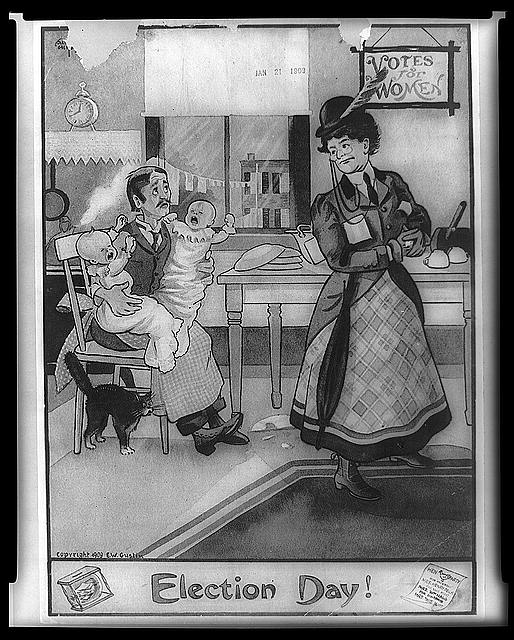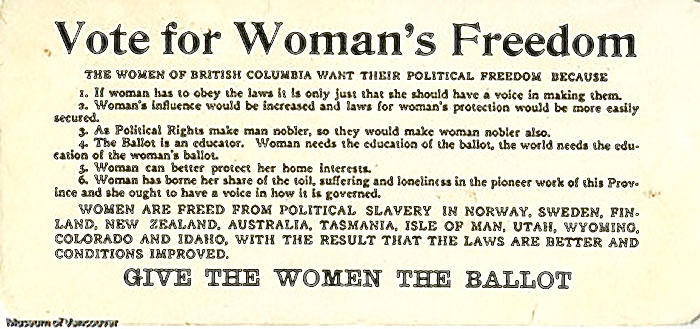Women’s Suffrage in Canada
Women’ Suffrage in British Columbia
(Jan 2018 1300)
The Long Slow Climb
Over the past few years, considerable attention is given to the lack of women’s rights within many religious orders, with Muslims taking the brunt of the heat over the past fifteen years. Yet, we only need to go back fifty or sixty years to see the fight for basic women’s rights, including the right to vote, was an ongoing battle in many parts of Canada.
It was not until the 1940’s that the women of Quebec were able to overcome a church dominated political system and gained that right too vote. Other rights would slowly be gained over the subsequent decades (e.g. removal of abortion and prostitution from the criminal code, equal rights within marriage, right to enter drinking establishments, and the list goes on), rights that today we take for granted.
It took until 2015 for women to be fully represented in ministerial positions within the Federal government and only in recent decades have we seen more women elected to lead Provinces. It’s no real surprise to anyone, that these women were and are powerful leaders. The United States has yet to break that barrier, but there is no doubt it will happen one day soon.
Over the nearly 150 years since our Confederation, these were big steps as it was just over 100 years ago that not one woman in Canada had the right to vote or hold legislative or parliamentary office. It’s hard to imagine it was only in 1916 that the legislative and parliamentary house of cards controlled exclusively by men, began to crumble when the women of Manitoba achieved the right. The right soon flowed across Canada as outlined in the following timeline.
1916 Manitoba, Saskatchewan and Alberta
1917 British Columbia and Ontario
1918 Nova Scotia and, as well, across Canada in the Federal system
1919 New Brunswick and Yukon
1922 Prince Edward Island
1925 Newfoundland and Labrador
1940 Quebec (Quebec was still largely controlled by the Catholic Church – Italian women only gained the right in 1945)
1951 Northwest Territories
1962 Status Rights for Aboriginal Women
For a list of that right be acquired in other countries Link Here
The black areas of the “suffrage map” of North America show the Provinces and States in North and Central America that were still “working” on achieving full suffrage for women as late as the 1940’s (Quebec) and 50’s. Area’s in white had largely achieved full suffrage by the 1920’s.
As recent as the 1950s, when I was a teenager, women were prohibited from entering bars in Saskatchewan. Mom, Louise and I used to wait for hours in the lobby while dad partied with his male friends in the beer parlour. Women dared no enter and chid her husband for taking to long.
While the changes over the early part of the last century were seismic, the distance to be travelled was still great, as many women had yet to achieve sexual and workplace equality. Many were (and still are) being abused in the most unseemly ways in the workplace where the power of men holds sway. One day that house of cards will also begin to crumble and many men will be held accountable for their misdeeds.
During my years as a police officer (1964 – 1994) women were just gaining a foothold in the military, police, fire department, and similar emergency service organizations. It was a tough battle as the ‘old boys network’ conspired at every turn to thwart their advancement and a place where sexual opportunists, did not shy away from taking advantage whenever and wherever the opportunity arose. During those times, it was career death women who complained and even when they did, their complaints most often fell on deaf ears.
Following are a few photos and cartoons depicting an earlier era.
1950 statement: “The next thing you know, women will want to play hockey! That’s not possible as it’s far too dangerous for their fragile bodies.” 2014: Team Canada heads to the Olympics. Across the spectrum, women’s team sports, women have gained a tremendous degree of respect on the world stage.


1950’s Do it Yourself Booklet
Watch the NetFlix series “Ad Men” to get a real sample of what it was like
for many women back in the 1950’s. The following booklet was not that far off the mark in many households.




I still think “O Canada” needs a slight word change that embraces gender equality. It may seem to some like the word “son” is of small import, but what is wrong with us?




(2476)
Trackback from your site.



